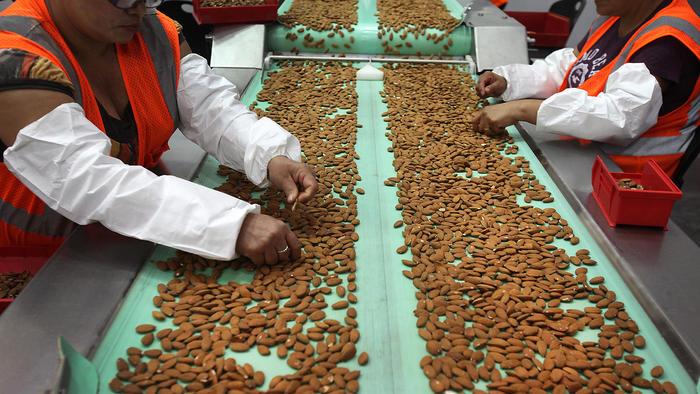Why Almond Farmers Aren’t the Water Enemy
by Brad Gleason
A quarter-century ago, when I first started farming the fertile ground of western Fresno County, my crop was cotton.
I wasn’t alone. Back then, the San Joaquin Valley had more than 1 million acres of white gold. Federal water cost me — hard to believe today — only $25 an acre-foot. And there was plenty of it. My neighbors and I irrigated inefficiently by sprinkler and furrow.
But I knew then that cotton wasn’t a sustainable crop for California. It could grow almost anywhere, and there was a surplus of it. Plus, cotton growers got a rather considerable payment from the federal government. Those double subsidies — cheap water and price supports — gave cotton growers a black eye. We were portrayed, with some justification, as the greedy farmers of Fresno’s west side.
So my farming partner and I decided in 1989 to plant our first almond trees on 40 acres outside Coalinga. Almonds were a higher-value crop, and there were no crop subsidies for nuts, which was a good thing for the American taxpayer. Also, if the price of water rose — and it certainly did — almonds produced a higher return to offset that cost.
In the years since, we have planted thousands more acres of almonds and pistachios. Once again, we’re not alone. Up and down the valley, orchards of nuts now exceed 1 million acres. Only 200,000 acres still grow cotton. And where furrows once dominated, you’ll find the precision of drip irrigation.
But now we’re the bad guys again. Article after article in newspapers, magazines and online put nut growers in a bad light related to the drought. The whole equation seems to be reduced to a single number wielded by our critics: It takes one gallon of water to grow one nut.
Boy, that sounds wasteful. It’s a figure designed to outrage, and it does the trick.
But looking at the societal value of producing food only by gallons of water used is silly, if not absurd. My fellow growers of other crops calculate that it takes about 168 gallons of water to produce a single watermelon. And 50 gallons for a cantaloupe. That head of broccoli that you feel good about serving to your child? Thirty-five gallons. A single ear of corn requires roughly 40 gallons.
I planted my almonds based on a contract with the federal government to deliver surface water from Northern California. I didn’t anticipate the contractual supply dropping to zero for two straight years; I didn’t foresee having to dig wells deeper into the earth of my farm to pump groundwater to make up the difference. Yes, almonds are a “permanent” crop with a life span of 18 to 20 years, and they don’t offer me the easy option of fallowing orchards in drought as some vegetable farmers have done. But let me point out that my almond trees are a lot less permanent than the houses that continue to get built in California on the same dwindling water supply.
Drive across the expanse of farmland around us and you’ll be hard pressed to find a puddle. That’s not because of the lack of rain. That’s because of the efficiency of irrigation. Out here, every gallon of water is measured from ditch to drip line.
With the curtailment of federal water deliveries, farmers are paying, on average, $1,000 an acre-foot for any surface water piped in on the open market. So you can bet that we’re not using a drop more than we need to keep our trees alive and productive.
I’m proud to be a farmer of almonds and pistachios. We produce something real and healthful that contributes mightily to the economy of California. Last year, farm gate sales for nuts alone topped $7 billion in our state. The export market is healthy and so is domestic consumption. Ask the county tax assessor what the rising value of nut acreage has meant for the tax rolls, and you’re likely to get a big smile.
Some of the old-timers still remember when this stretch of Fresno County belonged to the horned toad, jack rabbit and tumbleweed. Just as the architects of the Central Valley Project envisioned, water and man’s ingenuity turned the middle of California into the world’s most productive agricultural region.
Over time, farmers have adapted to answer the demands of water shortage, new crops, cities and fish, and I know we’ll continue to adapt as California confronts a new era of limits. But demonizing us — and what we grow — is no way to meet the challenge. We’re not the bad guys.
Source: LA Times.





